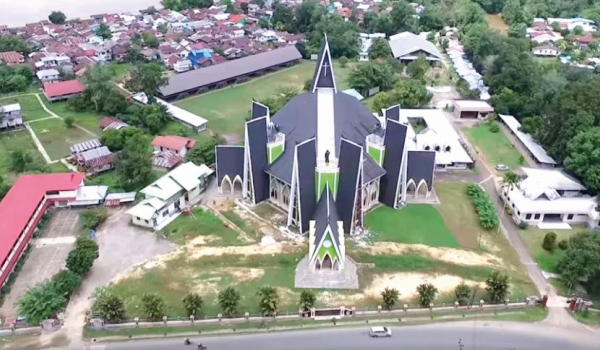
Sanggau is a regency in province of West Kalimantan. It is situated in the middle and in the northern part of the province, with an area of 12,857.70 km and a population density of 32 inhabitants per km in 2010.
As of 2017, a total of 565,600 people lived in the territory. The natives of Sanggau and Sekadau districts in West Kalimantan are the Dayak people (55 percent), but now the districts have Malay (30 percent), Javanese (7 percent), Chinese (5 percent) and others (3 percent).
Forty years ago, the government started so-called transmigration program and built many transmigration settlements for Muslims transmigrants. Due to local people’s rejection, the government quietly stopped the program.
Since the 1980, Sanggau district has become a major oil palm project. Many national and international companies developed huge oil palm plantations covering hundred thousands of acres. It is in the context of these projects that also a lot of outsiders arrived from Java and Sumatra to Sanggau to work in the plantations.
Following the Javanese defeat in the World War II, the missionaries collected in Malaysia returned to Kalimantan, and apostolic administrator of Pontianak Monsignor T. Van Valenberg invited more religious congregations to work in Kalimantan.
The presence of the missionaries allowed the decanate of Sanggau to build new mission stations in Sekadau (1950), Jangkang (1952), Pusat Damai and Pakit (1955), and Batang Tarang (1958).
On April 9, 1968, prefecture apostolic of Sekadau was erected under the service of Italian Passionist priests.
On June 8, 1982, it was elevated to a diocese. The decleration of the elevation was received on July 10, but the diocese marks its anniversary on Dec. 5 because it was inaugurated on Dec. 5, 1982.
The diocese of Sanggau included the whole apostolic prefecture of Sekadau and Sanggau decanate. Sanggau parish was chosen as the diocesan center bacause it is the capital of the district.
During the establishment, the diocese was led by Administrator Apostolic Monsignor Hieronimus Bumbun, OFMCap, who was aslo archbishop of Pontianak. Only on June 3, 1990, the diocese had its first bishop, Passionist Bishop Yulis Mencuccini.
The diocese of Sanggau started with nine parishes with 106,878 Catholics, and now it has 25 parishes with 357,017 Catholics.
Oil palm plantations have connected the remote villages with roads, but river transportation is the main mode in the diocese.
The main industries in the diocese are rubber and timber. But now, in most villages of the diocesan territory we find oil palm plantations. Majority of the people now get their livelihood as workers in oil palm companies. Several credit unions are available in the diocesan territory.
The telecommunication in the diocese is not so good. Not all parts in the diocese can be reached by phone, the Internet, television and radio. But regarding the dominant and most influential media of television, almost every house, even in remote regions, is equipped with parabola antenna and the people have access to more than hundred domestic and foreign channels.
The education in the capitals of the districts is good, but illiteracy is more prevalent in hinterland or rural areas of the two districts due to the limitation of schools and teachers caused by financial problems.The present government tries to offer additional opportunities of education and schooling to the people who live in remote regions. According to the law, all children are requested to attend nine years of basic education: six years elementary and three years secondary level. During the last ten years, however, this target was ‘almost’ met. In many remote villages there are public schools and most children are able to attend elementary or even secondary education.
Sanggau diocese is rich in Dayak cultures. The Dayak parishioners in hinterlands still live in Dayak traditional house called "betang" built in many cultures. Dayak has many tribes. The Dayak tribes in the diocese are Mali, Budayuh, Desa, Mualang, Ketungau and Kerabat.
Dayak people have some big traditional feasts. One of them is Ganjor’ro or Gawai of Mali Dayaknese, celebrated annually for three to seven days in villages after the harvest of rice. Tuak, a local alcoholic drink, always becomes a part of the feast.